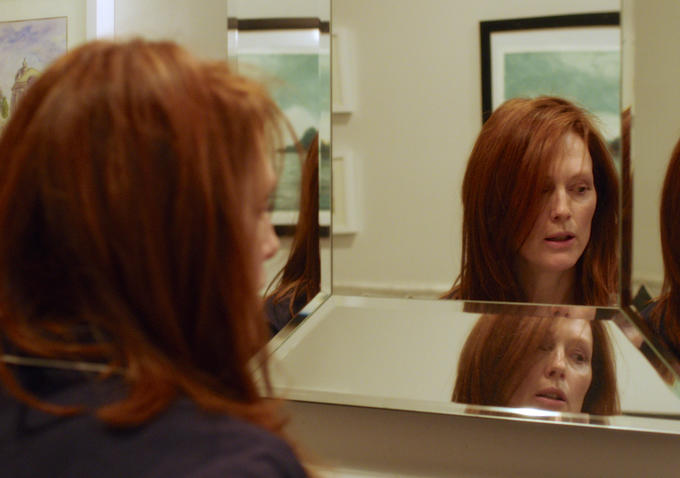 Back to selection
Back to selection
In the Family Way: Still Alice

To watch Julianne Moore portray a 49-year-old woman diagnosed with early-onset Alzheimer’s might be as close as one can get to understanding the disease and its effects on patient and family without having oneself received a positive diagnosis. Make no mistake, though: Still Alice is no downer. It is a closely observed and brilliantly performed story of struggle and — how can I write this out without appearing trite? — love.
Director-driven it is not. Yes, it is nicely shot (by Olivier Assayas’s frequent DP Denis Lenoir) and suitably edited. Filmmakers Richard Glatzer (whose battle with ALS since 2011 became an impetus to the project and informs a significant amount of the perspective) and Wash Westmoreland, his husband and caregiver, provide all of the actors, not just Moore, space to play out their parts. Kristen Stewart, who has the same signature upper-lip arch as Moore, does an excellent job as Alice’s youngest child, the black sheep Lydia, bouncing nicely off Moore in scenes both smooth and contentious. Alec Baldwin as Alice’s husband, John, and Kate Bosworth as haughty daughter Anna are unexceptional but serviceable.
The writer/filmmaker team creates plot points that keep Alice’s family members from being purely two-dimensional types (except for son Tom, portrayed by Hunter Parrish, a sweet, conventional young man who has little to do except passively support his mother — but then he is there to be, as might be expected from the directing duo, gay and suavely handsome). The illness is “familial,” i.e., hereditary, and pregnant Anna and her husband fret and discuss testing to find out if she is positive for the responsible gene. Poor, poor opportunistic John, a renowned medical researcher, wrestles with the contradictory demands of a wife who desperately needs the safe familiarity of his presence and the Mayo Clinic, which has offered him a plum post if he is willing to drop everything and move immediately to Minnesota. But this is no ensemble piece, as some Cannes reviews insisted. Most of the time all eyes–relatives’ and ours–are on Alice.

My biggest problem with the screenwriter/director duo is the embourgeoisement of the enterprise, from first frame to last, and, if I may extrapolate, of Glatzer and Westmoreland’s careers. The milieu, Manhattan’s Upper West Side and Columbia University, is light years away from the working-class Latino barrio in L.A. that was the setting of their Sundance Grand Jury Prize-winning Quinceanera (2006), although those earlier subjects did prominently include a comfortable, attractive gay white male couple, interlopers who had recently moved into the neighborhood. It’s not just because the shared subject is a degenerative disease, albeit one that atrophies the mind instead of the body, that Still Alice recalls Norman Rene’s inert AIDS-era standard Longtime Companion (1989), the intertwined tragic tales of well-to-do gay white men on Fire Island. Glatzer and Westmoreland have revamped the formula, making almost everyone straight and transposing most of the action to the city, even if they almost gratuitously add a few precious scenes on “the island.”
Alice herself is bourgeois, ordered, tasteful. She clings tight to her values, her class and position. She is a well-known academic who lectures all over the world. After she falls ill, she delivers a speech at an Alzheimer’s organization meeting in which she compares her urge to survive with the ambition that characterized her professional life before she was forced by negative student evaluations to give up. John and Anna’s universes are highly structured as well. They are not subtle with their impatience once Alice becomes a disruption.
With Moore in the lead, Still Alice qualifies as proudly actor-driven. Think of Moore/Alice as a spindle, with everything else revolving around her. You become so fixated, it’s as if you have become part of a concentric movement. She deteriorates, you care. Moore is so extraordinary that no one will regret subjecting themselves to a movie about prolonged mental rot. Ever the lifesaver for directors and screenwriters, she manages to surpass occasional overloading of her character by Glatzer and Westmoreland, who took their cues from author Lisa Genova’s novel, on which the film is based. The person losing her recall function is a cognitive psychologist teaching Linguistics 201 at Columbia? And the first extra-familial incident of memory lapse takes place during a lecture? There’s more. It’s not just a word she forgets: It’s the subject!
What makes Moore one of the finest performers working in cinema today is her lack of mannerisms, and here the nuances she engages to convey the spiraling effects of such a tragically debilitating illness make Alice not only credible and real, they also make her singular. Genova’s self-published novel (no publisher would take it), set around Harvard, not the film’s Columbia, is written largely from Alice’s point of view; she retains her individuality even as her mind goes. (Genova knows of what she writes: She has a PhD in neuroscience and has done a lot of research in the area.) Like the Best Actress prize at Cannes, the recent Gotham is, I’m sure, among several that will have gone Moore’s way by the end of awards season.
The decline is erratic. Moore plays her like someone going through a 12-step exercise. The disease affects her initially in small gradations, so that the actress has to carefully modulate her gestures and response times. The directors have said that they shot as much as possible in chronological order to accommodate her for such a complex interpretation. The alterations begin to increase more rapidly. Alice looks gaunt; she fusses around maniacally, becomes more and more lost, has accidents.

Intelligence can be an enemy. On the plus side, her neurologist doctor explains, it often delays the onset of the disease. Once it begins whittling her down, she not only tries to reach past her limitations, she is also on the outside looking in. A cognitive psychologist does not entirely shed her worldview while she short-circuits. We understand her desire to control the attack on her brain function, to use electronic gadgets to keep the conscious Alice up-to-date with what is happening with her deteriorating double.
She records like mad, instructs herself for future tasks she knows she will soon be unable to perform—like a suicide plan for when she feels she is at the precipice of dementia. She knows that association will be the key to following her own orders, so she creates a file called “Butterfly,” arranged to pop up when it becomes too complicated for her to sort such matters out. That she names her death order for her trademark lepidoptera jewelry is telling: She is not only cerebral, she is also spirited.
By no means is she unemotional–she deeply loves her children and husband, and she tends to become slightly hysterical sick or not. By nature and habit, she is just more trusting of the intellect. She attempts to remain attached to rational thought processes like a leash to a collar, knowing full well that relinquishing control will only create more chaos in the vertiginous vortex that has become her place in the world. Imagine not being able to let go of anything—an object, a piece of information, a loved one–for fear that it might forever remain outside your grasp.
The sicker she gets, the more marginalized she becomes, as very sick people tend to do. The most empathetic member of the family turns out, predictably, to be fellow outcast Lydia. She has blown off higher education against her mother’s wishes and moved to L.A. to study acting. While the Alice who has already lost much of her faculties still harps on college as “a back-up plan” for her daughter, she has mellowed enough to understand when Lydia informs her she neither needs nor wants one. “I believe in myself” is now sufficiently convincing.
The bond between the two grows, Lydia rising to the occasion as much by desire as default. Returning home from California is a major sacrifice, especially when two other siblings live in New York City, but she is stoic. Unlike the others, she treats her mother like a human being, calling her on using her sickness as a crutch or an excuse. After Alice appears beyond rational thought or coherence, Glatzer and Westmoreland wisely yank the intellectual template altogether, enabling overpowering affect alone to rule. Dramatically, the strategy works like a charm. At the same time, the catharsis is well-deserved for Alice, for Lydia, and for those of us who have embarked on a compressed version of a journey that we discover is not 100 per cent negative and cruel: It is also bittersweet.
